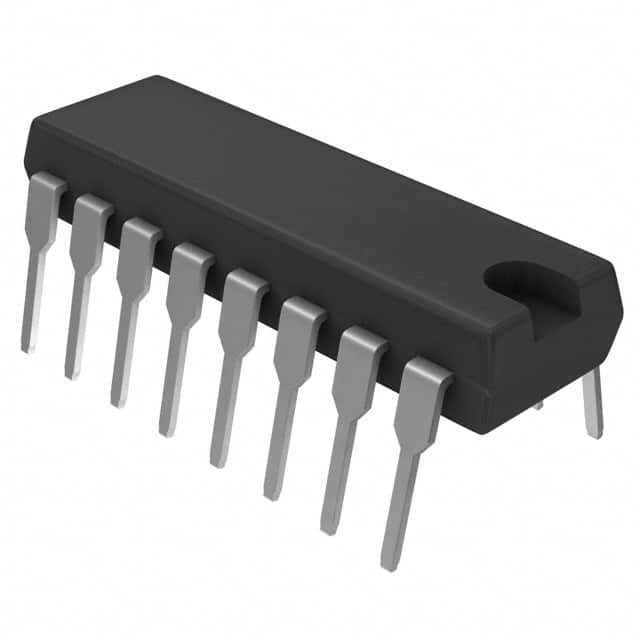Vedi le specifiche per i dettagli del prodotto.

CD74HCT85E
Product Overview
- Category: Integrated Circuit
- Use: Arithmetic Logic Unit (ALU)
- Characteristics: High-speed operation, low power consumption
- Package: DIP (Dual In-line Package)
- Essence: 4-bit magnitude comparator
- Packaging/Quantity: Tube packaging, 25 pieces per tube
Specifications
The CD74HCT85E is a 4-bit magnitude comparator integrated circuit. It operates at high speeds while consuming low power. The device comes in a Dual In-line Package (DIP) and is packaged in tubes containing 25 pieces each.
Detailed Pin Configuration
The CD74HCT85E has a total of 16 pins, which are assigned specific functions as follows:
- A0 - Input A, bit 0
- A1 - Input A, bit 1
- A2 - Input A, bit 2
- A3 - Input A, bit 3
- B0 - Input B, bit 0
- B1 - Input B, bit 1
- B2 - Input B, bit 2
- B3 - Input B, bit 3
- LT - Less Than output
- EQ - Equal output
- GT - Greater Than output
- GND - Ground
- C0 - Carry output, bit 0
- C1 - Carry output, bit 1
- C2 - Carry output, bit 2
- VCC - Power supply
Functional Features
The CD74HCT85E is primarily used as a 4-bit magnitude comparator within arithmetic logic units (ALUs). It compares two 4-bit binary numbers, A and B, and provides three outputs: LT (Less Than), EQ (Equal), and GT (Greater Than). These outputs indicate the relationship between the two input numbers.
The device operates at high speeds, making it suitable for applications that require quick comparison operations. Additionally, it consumes low power, making it energy-efficient.
Advantages and Disadvantages
Advantages: - High-speed operation - Low power consumption - Accurate comparison results - Compact DIP package
Disadvantages: - Limited to 4-bit comparisons - Requires external circuitry for larger bit comparisons
Working Principles
The CD74HCT85E compares the binary values of inputs A and B using a combination of logic gates. It determines whether A is less than, equal to, or greater than B based on the binary values of each corresponding bit. The outputs LT, EQ, and GT reflect the result of this comparison.
Detailed Application Field Plans
The CD74HCT85E is commonly used in various applications that require binary number comparison. Some specific application fields include:
- Microprocessors: ALUs within microprocessors utilize the CD74HCT85E for arithmetic and logical operations.
- Digital Signal Processing: The comparator is employed in digital signal processing systems for comparing data values.
- Communication Systems: CD74HCT85E finds use in communication systems for error detection and correction purposes.
- Industrial Control Systems: The device is utilized in industrial control systems for monitoring and controlling processes.
Detailed and Complete Alternative Models
- SN74LS85 - 4-bit magnitude comparator with similar functionality but different package type (SMD)
- CD54HC85 - 4-bit magnitude comparator with higher speed operation but higher power consumption
- MC14585 - 4-bit magnitude comparator with additional features like latch enable and cascading capability
These alternative models offer similar functionality to the CD74HCT85E but may differ in terms of package type, speed, power consumption, and additional features.
Word count: 420 words
10 domande e risposte comuni relative all'applicazione di CD74HCT85E nelle soluzioni tecniche
Sure! Here are 10 common questions and answers related to the application of CD74HCT85E in technical solutions:
Q: What is CD74HCT85E? A: CD74HCT85E is a high-speed CMOS (Complementary Metal-Oxide-Semiconductor) 4-bit magnitude comparator integrated circuit.
Q: What are the key features of CD74HCT85E? A: CD74HCT85E features low power consumption, wide operating voltage range, high noise immunity, and compatibility with TTL (Transistor-Transistor Logic) inputs.
Q: How does CD74HCT85E work? A: CD74HCT85E compares two 4-bit binary numbers and provides outputs indicating whether one number is greater than, equal to, or less than the other.
Q: What are the typical applications of CD74HCT85E? A: CD74HCT85E is commonly used in digital systems for tasks such as address decoding, data routing, arithmetic operations, and control logic.
Q: What is the maximum operating frequency of CD74HCT85E? A: The maximum operating frequency of CD74HCT85E is typically around 50 MHz.
Q: What is the supply voltage range for CD74HCT85E? A: CD74HCT85E can operate within a supply voltage range of 2V to 6V.
Q: Can CD74HCT85E handle both active-high and active-low inputs? A: Yes, CD74HCT85E supports both active-high and active-low inputs, providing flexibility in system design.
Q: Does CD74HCT85E have built-in output latches? A: No, CD74HCT85E does not have built-in output latches. The outputs directly reflect the comparison results.
Q: What is the power dissipation of CD74HCT85E? A: The power dissipation of CD74HCT85E depends on factors such as supply voltage, operating frequency, and load conditions. It is typically low due to its CMOS technology.
Q: Is CD74HCT85E available in different package options? A: Yes, CD74HCT85E is available in various package options, including DIP (Dual In-line Package) and SOIC (Small Outline Integrated Circuit).
Please note that these answers are general and may vary depending on the specific datasheet and manufacturer's specifications for CD74HCT85E.

